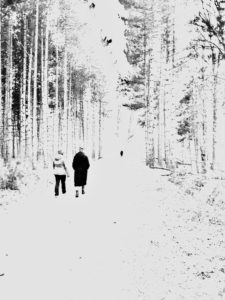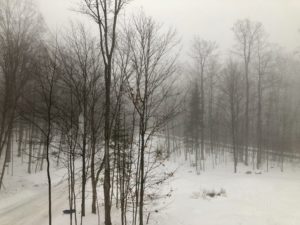The post-holiday elation is upon us.

Photo: Ana Sgambato & Margarita Rabinovich, 2019 “Winter friendship.”
I wonder if the snow loves the trees and fields, that it kisses them so gently? And then it covers them up snug, you know, with a white quilt; and perhaps it says “Go to sleep, darlings, till the summer comes again.”
Lewis Carroll, Alice’s Adventures in Wonderland / Through the Looking-Glass
The winter blues are real, and so is the pandemic.
After the Holiday Season is over, most people find themselves experiencing a cluster of uncomfortable symptoms. This year 2020, is quite different and more complicated because of the drastic and necessary life changes caused by the COVID-19 pandemic.
The most common symptoms of Seasonal Affective Disorder (SAD) are now blending with the pre-existing anxiety and mood changes that many are currently experiencing due to the pandemic:
- Depressed mood.
- Loss of interest in activities you often enjoy.
- Loss of feeling of pleasure.
- Appetite and weight changes.
- Feeling angry, irritable, more anxious than usual.
- Feeling more aches and pains.
- Changes in sleeping patterns.
- Fatigue, lack of energy, and reduced sex drive.
- Difficulty concentrating.
- Increased use of drugs or alcohol for comfort.
- The feeling of sadness, hopelessness, and despair.
Most of the symptoms are similar to what we know as major depression. What does make Seasonal Affective Disorder (SAD) different from major depression?
The rest of the year, especially during the Summer and Spring, our mood is more uplifted; we feel more energy and find pleasure and joy in doing things we most like. If we experience depression throughout the year, some of the symptoms can exacerbate during the winter. If we experience grief and bereavement, it can also affect how we go through the winter season. This year, we need to pay more careful attention to ourselves and our loved ones as we go through the seesaw of emotions due to the pandemic.
The COVID-19 pandemic complicates some of the options and different ways we usually beat the winter blues.
The typical recommendations for coping with SAD are: being more social, getting outdoors, joining a gym and exercising, indoor swimming, massage therapy, flotation therapy, joining indoor activities such as concerts, movies, or theatre plays.
These activities are currently challenging because of the precautions and physical distance we must take due to the COVID-19’s highly contagious characteristics.
We are not different from the trees: focusing our energies on making it through the winter.

Photo: Margarita Rabinovich, 2019 “Dormant Giants”
Seasonal affective disorder can remind us how much we are in sync with nature’s different cycles. A healthy and robust relationship exists between trees and humans. As we breathe in oxygen and exhale carbon dioxide, trees breathe carbon dioxide and exhale oxygen. That’s how much we rely on trees!
Similar to how the trees change and harmonize with the different seasons year-round, so do we. Trees enter a period of dormancy during the cold temperatures and of less exposure to sunlight. They slow down their metabolism, growth and energy consumption. They stop growing.
For us humans, the shorter days and reduced exposure to sunlight create changes in our internal clock or circadian rhythm, leaving us feeling groggy and sleepy. Darker days lead our body to produce more melatonin, leaving us feeling tired and low on energy. Less exposure to light makes our body produce less serotonin, which function helps to regulate mood.
Resilience through the lenses of different cultures.
Cultures and societies that are keen to stress come up with words that become containers of a particular experience. There is such beauty in having a word that describes an experience! It’s not always easy to put in words how we experience and relate to hardship.
Some words that we can consider using to inspire us to imagine ways to face the mental health challenges throughout the wintertime:
- The Norwegian and Danish people’s idea of ‘hygge,’ which means comfortable coziness and conviviality. The word holds the idea of feeling content with the simple and ordinary life moments, and that doesn’t require adopting a certain lifestyle or buying something.
- The Swedish concept of ‘lagom’, which is all about balance, moderation and simplicity. It’s mindful awareness of knowing the right amount and what is most essential in our lives; and when something doesn’t serve us anymore.
- During the last 100 years, Finnish history has reinforced the notion of ‘sisu’ as a particular Finnish trait. There is almost a mythical air to the idea of Sisu. It is considered vital energy, determination in the face of adversities that are more demanding than usual. Sisu encompasses the idea of perseverance and dignity in the face of adversity.
- The Japanese word ‘ganbaru’ means going tenaciously through difficult times and doing our best. The word ganbaru also means enduring adversity without giving in to it.
- The Tibetans have the word ‘lojon’ that is translated as mind-training, but the closest meaning is ‘refining’ the mind rather than the mind’s training. The practice involves cultivating resilience, compassion and psychological flexibility. It uses meditation to tame and quiet the mind from negative thoughts.
Finding a balance between the ideas of endurance and determination with conviviality and compassion is a healthy way to go through the hardship of stressful times. There are no benefits in suffering in silence and ‘toughing it up”. Self-compassion, self-kindness and talking to someone we trust are incredible sources of strengths and healing.
How can we adjust to the winter season during the COVID-19 pandemic without losing our minds?
Make an effort to go outside every day. If you are physically able, take a short walk. If you feel lazy or find walking too boring, listening to your favourite music, radio or podcast helps keeping you going and entertained. Get your headphones ready and step out of your home.
Have your coffee or tea outside if you can keep yourself warm enough. Keep the blinds and drapes open and sit close to the windows and natural light, most especially if your workstation is at home.
Keep your favourite music in the background to uplift your mood. Music is a beautiful companion!. Our favourite playlists provide a comfortable activation level and create the right environment for eliciting positive feelings.
Coordinate with other people living in your house or, if you live alone, with friends you can video-chat and exercise together. Otherwise, you can find some free classes offered online. If you can engage in continuous and rhythmic movements for 20 to 30 minutes each day like dancing, weight lifting, walking, you’ve got this!
Light therapy or a dawn simulator can be effective. Talk to your doctor because the timing and length of exposure needed can vary. If you use a Lightbox or lamp in most cases, you sit about 12 inches in front of a 10,000-lux Lightbox for 15 to 30 minutes each morning. (If you are diagnosed with bipolar disorder, it’s advisable to consult with your doctor or mental health professional since light-therapy can trigger a manic episode, in which case a dawn simulator can be a better option.)
Connect with people who can help you curb negative thoughts, attitudes, and behaviours that worsen the seasonal affective disorder. Connect with someone who can help you learn how to manage symptoms and deal with stress and perhaps the effects of isolation due to the pandemic. For some people, mindfulness-based individual therapy can be beneficial.
Practice relaxation techniques. You can follow this link and listen to the audio containing a full-body relaxation guided exercise that I’ve recorded. You can subscribe to a youtube channel or App that offers guided breathing exercises and meditation or other full-body relaxation techniques. Taking a warm bath and listening to calming and soothing music before bedtime is an excellent way to prepare our bodies and minds for sleep.
Journaling can help us get our thoughts down on paper and stop ruminating and worrying over them. Writing can give us a chance to process the loss of engaging in our usual activities and with the people we care about the most due to the pandemic. Journaling has its place in processing grief and bereavement, helping us to identify and release our emotions. It enhances our self-awareness and helps us identify triggers and how to deal with them. Writing down about the things, experiences and people we are grateful for is like adding a dose of contentment into our lives. It can have long-lasting effects in gaining a larger and broader perspective about our place in the world.
Taking pictures can be a way of practicing mindfulness and engaging with the beauty of winter landscapes or rediscovering places, people, pets, and objects inside our home with a different set of eyes. Taking pictures is a way of journaling our days through images and capturing our special moments throughout the day … or turning the moment into something special. Mindful photography helps us redirect our attention from inward to outward and pay attention to our environment with deeper insight. We can add a brief story to the photos we take, giving voice to our emotions and narratives we hold in our mind and heart. We can share the pictures with others.
Hanukkah Sameach, Merry Christmas, Heri za Kwanza, However you celebrate this season, I send you my sincere wishes of harmony and hope. May this time of year be a reminder of the essential things in life. Most of all, I wish you inner peace through difficult times, Margarita.

